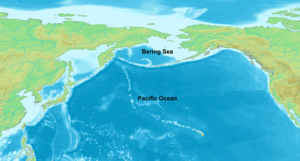Bering Sea facts for kids
The Bering Sea is a large part of the Pacific Ocean. It has very deep areas and also shallower parts. These shallow areas are above the continental shelves, which are like underwater ledges.
The Bering Sea is huge, covering more than two million square kilometers. It is next to Alaska in the east and northeast. To the west, it borders Russia's Siberia and the Kamchatka Peninsula. To the south, you'll find the Alaska Peninsula and the Aleutian Islands. In the far north, the Bering Strait connects it to the Arctic Ocean's Chukchi Sea.
A part of the Bering Sea called Bristol Bay separates the Alaska Peninsula from mainland Alaska. The sea is named after Vitus Bering. He was a Danish explorer working for Russia. In 1728, he was the first European to explore this sea in a planned way.
The Bering Sea is home to many important natural resources. These resources are shared by the United States and Russia. There are also international waters in the middle of the sea, which means no single country owns them.
Contents
How the Bering Sea Helped People Move Around
Most scientists believe that during the last ice age, the sea level was much lower. This allowed humans and animals to walk from Asia to North America. They crossed what is now the Bering Strait. This path is often called the "Bering land bridge." Many think it was the first way humans entered the Americas.
Islands of the Bering Sea
The Bering Sea has many islands. Some of the main ones include:
- Pribilof Islands
- Komandorski Islands, which includes Bering Island
- St. Lawrence Island
- Diomede Islands
- King Island
- St. Matthew Island
- Karaginsky Island
- Nunivak Island
- Sledge Island
- Hagemeister Island
Parts of the Bering Sea
The Bering Sea has several important areas:
The Bering Sea also has 16 submarine canyons. These are like deep valleys underwater. The largest one in the world, Zhemchug Canyon, is found here.
Amazing Animals of the Bering Sea
The Bering Sea is full of incredible wildlife. It supports many types of whales that are in danger of disappearing. These include the Bowhead Whale, Blue Whale, Fin Whale, Sei Whale, Humpback Whale, and Sperm Whale. The rarest whale in the world, the North Pacific Right Whale, also lives here.
Other marine mammals you might find are walruses, Steller Sea Lions, Northern Fur Seals, Belugas, Orcas (also known as killer whales), and polar bears.
The Bering Sea is also very important for seabirds. More than 30 different kinds of seabirds live and raise their young here. About 20 million individual birds call this region home. Some seabirds found here are Tufted Puffins, the endangered Short-tailed Albatross, Spectacled Eiders, and Red-legged Kittiwakes.
Sadly, two animals that once lived in the Bering Sea are now extinct. These are the Steller's Sea Cow and the Spectacled Cormorant. They disappeared because people hunted too many of them. Also, a small type of Canada goose, the Bering Canada goose, became extinct due to too much hunting and rats being brought to their breeding islands.
The Bering Sea is also home to many kinds of fish. At least 419 different fish species have been found here. Some of these fish are very important for fishing businesses. These include 6 types of Pacific Salmon, Alaska Pollock, Red King Crab, Pacific cod, Pacific halibut, Yellowfin Sole, Pacific ocean perch, and sablefish.
Images for kids
-
The Russian "Rurik" sets anchor near Saint Paul Island in the Bering sea in order to load food and equipment for the expedition to the Chukchi sea in the north. Drawing by Louis Choris in 1817.
-
Aerial view of Tutakoke Bird Camp on the coast of the Bering Sea, south of Hooper Bay
See also
 In Spanish: Mar de Bering para niños
In Spanish: Mar de Bering para niños








